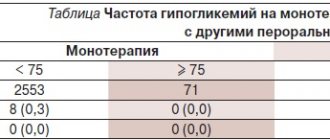Olanzapine
Hyperglycemia and diabetes mellitus
There is a higher prevalence of diabetes mellitus in patients with schizophrenia. There are very rare reports of the development of hyperglycemia and/or decompensation of diabetes mellitus, sometimes accompanied by the development of ketoacidosis or ketoacidotic coma, including reports of several fatal cases. In some cases, there was an increase in body weight preceding decompensation, which could become a predisposing factor. In patients with diabetes mellitus and risk factors for the development of this disease, regular clinical monitoring and monitoring of blood glucose concentrations is recommended.
Change in lipid concentration
During therapy with olanzapine, it is necessary to monitor plasma lipid concentrations in patients with dyslipidemia and in patients with risk factors for lipid metabolic disorders. Patients taking olanzapine therapy need to monitor their lipid profile. If lipid concentrations change, therapy adjustments are required.
Anticholinergic activity
In clinical studies, olanzapine therapy was rarely accompanied by adverse reactions due to blockade of M-cholinergic receptors. Because clinical experience with olanzapine in people with underlying medical conditions is limited, the drug should be used with caution in patients with clinically significant prostatic hyperplasia, paralytic ileus, angle-closure glaucoma, and similar conditions.
Use of olanzapine in patients with Parkinson's disease
Olanzapine is not recommended for the treatment of psychosis caused by dopaminomimetics in Parkinson's disease. Symptoms of parkinsonism and hallucinations increase. However, olanzapine was not superior to placebo in treating psychosis.
Dopaminergic antagonism
In vitro
Olanzapine exhibits dopamine receptor antagonism and, like other antipsychotics (neuroleptics), may theoretically inhibit the action of levodopa and other dopamine receptor agonists.
Experience with olanzapine in elderly patients with dementia-related psychosis. The effectiveness of olanzapine in elderly patients with dementia-related psychosis has not been established. In placebo-controlled clinical trials (lasting 6-12 weeks) in elderly patients (mean age 78 years) with psychosis and behavioral disturbances due to dementia, there was an increase in deaths in patients treated with olanzapine compared with placebo ( 3.5% versus 1.5% respectively). The increase in mortality was independent of the olanzapine dose or duration of therapy. Risk factors predisposing to increased mortality include: age over 75 years, dysphagia, sedation, malnutrition and dehydration, lung diseases (for example, pneumonia, including aspiration), concomitant use of benzodiazepines.
Cerebrovascular adverse events including stroke in elderly patients with dementia
Cerebrovascular adverse events (stroke, transient ischemic attack), including deaths, were observed in studies of olanzapine in elderly patients with psychosis associated with dementia. In placebo-controlled studies, there was a higher incidence of cerebrovascular adverse events in patients in the olanzapine group compared with the placebo group (1.3% versus 0.4%, respectively). All patients had previous risk factors for cerebrovascular adverse events (smoking, hypertension, previous cerebrovascular adverse event or transient ischemic attack), as well as concomitant diseases with medications temporally associated with cerebrovascular adverse events.
Postural hypotension
Postural hypotension was not frequently observed in elderly patients during clinical trials of olanzapine. As with other antipsychotic drugs, periodic monitoring of blood pressure is recommended in patients over 65 years of age.
QT interval
In clinical studies, clinically significant QT prolongation (QT interval correction [QTcF] ≥500 milliseconds in patients with baseline QTcF <500 msec) was rarely observed (0.1%-1%) in patients receiving olanzapine therapy for against the background of no significant differences with placebo in terms of associated cardiac events. However, as with other antipsychotic drugs, caution should be exercised when prescribing olanzapine concomitantly with drugs that can prolong the QT interval, especially in elderly patients, patients with long QT syndrome, congestive heart failure, cardiac hypertrophy, hypokalemia or hypomagnesemia. Electrocardiogram monitoring should be performed during olanzapine therapy.
Liver dysfunction
At the beginning of therapy, an asymptomatic increase in the activity of liver transaminases (ALT and AST) in the blood serum is often observed. Rare cases of hepatitis have been reported. In addition, there have been isolated reports of cholestatic and mixed liver damage. In patients with initially elevated serum AST and/or ALT levels, patients with liver failure and conditions that potentially limit liver function, and those taking hepatotoxic drugs, special caution should be exercised when prescribing olanzapine. If ALT and/or AST increase during drug therapy, medical monitoring of the patient and, possibly, a reduction in the dose of the drug are recommended. If hepatitis (including hepatocellular, cholestatic or mixed) is diagnosed, olanzapine should be discontinued.
Hematological changes
The drug should be used with caution in patients with leukopenia and/or neutropenia of any origin, myelosuppression of drug origin, as well as during radiation or chemotherapy, due to concomitant diseases, in patients with hypereosinophilic conditions or myeloproliferative diseases. Neutropenia was often observed with simultaneous use of olanzapine and valproic acid (see section "Side effects").
Neuroleptic malignant syndrome (NMS)
NMS is a potentially life-threatening condition associated with treatment with antipsychotic drugs (neuroleptics), incl. olanzapine. Clinical manifestations of NMS: fever, muscle rigidity, impaired consciousness, autonomic disorders (unstable pulse or labile blood pressure, tachycardia, increased sweating, arrhythmias).
Additional symptoms of NMS: increased CPK, myoglobinuria (against the background of rhabdomyolysis) and acute renal failure. If symptoms of NMS develop, as well as an increase in body temperature for no apparent reason, it is necessary to discontinue all antipsychotics, incl. olanzapine.
Convulsive syndrome
Olanzapine should be used cautiously in patients with a history of seizures or risk factors that lower the seizure threshold. Seizures were rarely reported while taking olanzapine.
Tardive dyskinesia
In comparative studies, olanzapine therapy was significantly less likely to be accompanied by the incidence of tardive dyskinesia requiring drug correction than the use of typical and other atypical antipsychotics. The risk of developing tardive dyskinesia increases with increasing duration of therapy. If signs of tardive dyskinesia develop in a patient taking olanzapine, dose adjustment is recommended. Symptoms of dyskinesia may temporarily increase after discontinuation of the drug.
General activity in relation to the central nervous system
Caution should be exercised when using olanzapine and other centrally acting drugs simultaneously and avoid alcohol consumption.
Thromboembolism
Cases of venous thromboembolism have been reported very rarely (less than 0.01%) when taking olanzapine. A cause-and-effect relationship between olanzapine therapy and venous thrombosis has not been established. Because patients with schizophrenia often have acquired risk factors for venous thrombosis, all possible other factors (eg, immobilization) should be identified and preventive measures taken.
Sudden death
Clinical experience with all antipsychotics, including olanzapine, has shown a similar dose-dependent increase in the risk of sudden death due to acute heart failure. In a retrospective observational cohort study, the risk of suspected sudden cardiac death in patients treated with olanzapine was increased approximately twofold compared with patients not using antipsychotics. In the study, the risk for olanzapine was comparable to the risk for the atypical antipsychotics included in the pooled analysis.
Long-term drug therapy
With long-term therapy with olanzapine (up to 12 months), in order to prevent relapses in patients with bipolar disorders, there was an increase in body weight of >7% from the original (in 39.9% of patients). With longer therapy (more than 48 weeks), clinically significant changes were observed - increases in body weight, glucose concentration, total cholesterol/LDL/HDL or triglycerides. In adult patients who completed a 9-12 month course of treatment, an increase in mean blood glucose concentration was observed after approximately 6 months. Patients with risk factors for the development of concomitant diseases who are on long-term therapy with olanzapine need to be monitored by a specialist during the entire course of therapy.
Withdrawal syndrome
When olanzapine is stopped abruptly, very rarely (less than 0.01%) the following symptoms may develop: sweating, insomnia, tremor, anxiety, nausea or vomiting. When discontinuing the drug, a gradual dose reduction is recommended.
Use in children
Olanzapine is not recommended for use in children and adolescents under 18 years of age due to the lack of sufficient data on efficacy and safety. In short-term studies in patients 13 to 17 years of age, more significant increases in body weight and changes in lipid and prolactin concentrations were reported than in similar studies in adults (see section "Side Effects").
Causes of overdose
Overdose with Olanzapine is rare. It is caused by misuse or attempted suicide. Most often it occurs:
- In people with significant mental disorders who have easy access to the drug and may take too much of the dose.
- In elderly people, due to a decrease in metabolic rate, when the next dose is taken against the background of a still high concentration of the substance.
- In children, if parents or relatives take the drug as prescribed by a doctor and leave it in a visible place.
- In case of disruption of the liver and kidneys, as they take part in the removal of the drug and its metabolites from the body.
- Incorrect dosage when trying to self-medicate.
- Used by drug addicts for pleasure.
- Individual reaction of the body.
Sometimes a patient with severe depression may use the drug to attempt suicide. If a person has such a tendency, he should not have free access to the drug. Taking the drug should be strictly supervised by medical staff or relatives.
Signs of poisoning
Overdose caused by Ozalanpin has not been sufficiently studied. There is information about clinical studies conducted in which 67 people took part. Patients were specifically selected from those who accidentally or intentionally took too high a dose of the drug. One of the study patients took 300 mg of the drug, and he experienced severe drowsiness and speech inhibition. None of these people developed severe changes on the electrocardiogram and had normal laboratory values. Experts indicated the preservation of all vital functions in all subjects.


